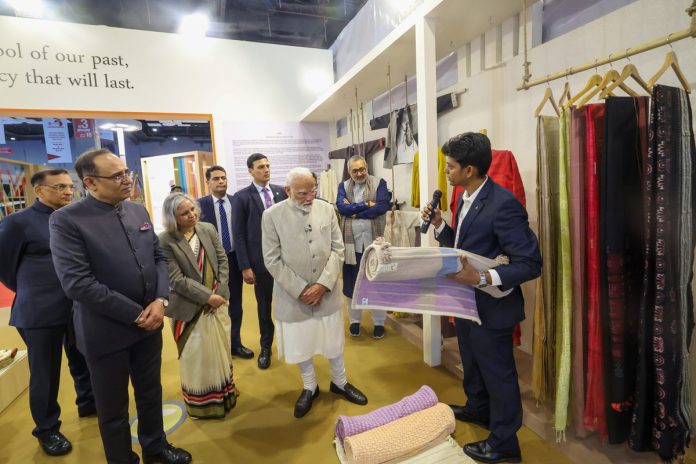India aims to triple its textile exports to ₹9 lakh crore by 2030, Prime Minister Narendra Modi announced on Sunday, expressing optimism that this target could be achieved even earlier. He emphasized the role of the “Five Fs” vision and emerging global opportunities worth $7.5 billion in textile waste recycling.
Speaking at Bharat Tex 2025 in New Delhi, Modi noted that India’s textile exports have already reached ₹3 lakh crore. He highlighted that the sector grew by 7% last year, earning India the rank of the world’s sixth-largest textile exporter. He urged the industry to strive for double-digit growth in the coming years.
Bharat Tex 2025, a major global textile event held from February 14-17, brings together the entire textile value chain, from raw materials to finished products. With exhibitors from 126 countries, the event provides Indian entrepreneurs exposure to over 120 markets, fostering global business expansion.
During his address at Bharat Mandapam, Modi described Bharat Tex as a symbol of India’s rich traditions and a step towards a “Viksit Bharat” (Developed India). He acknowledged the event’s role in supporting MSMEs, with some exhibitors stating that setting up a textile factory typically costs ₹70-75 crore and provides employment to approximately 2,000 people. He urged the banking sector to support MSMEs with adequate credit to drive growth and job creation.
The PM also encouraged Indian startups to explore textile recycling, predicting that this segment could become a $400 million industry domestically and a $7.5 billion market globally. He highlighted that foreign investment in India’s textile sector has doubled over the past decade, and the industry contributes 11% to the country’s manufacturing sector.
The newly announced Manufacturing Mission aims to further boost the textile sector with a focus on ease of doing business, workforce development, MSME growth, technological advancements, and quality improvements.
Additionally, Finance Minister Nirmala Sitharaman announced a Mission for Cotton Productivity in the Union Budget, aligning with the Five Fs vision. This five-year initiative will enhance cotton farming productivity and sustainability while promoting extra-long staple cotton varieties to benefit farmers and ensure a steady supply of high-quality cotton for India’s textile industry.
Modi reiterated his Five Fs framework—farm to fiber, fiber to factory, factory to fashion, and fashion to foreign markets—which gives India a unique advantage with its complete textile ecosystem. Inspired by this vision, the government launched seven PM Mega Integrated Textile Regions and Apparel (PM MITRA) Parks in October 2021.
India holds a 3.9% share in the global textile and apparel (T&A) trade, with the US and the EU accounting for 47% of its total exports. Experts attribute India’s recent export growth, particularly in jute products and garments, to political instability in Bangladesh. Jute product exports surged by 44% in October 2024, reaching $36 million, contributing to a 1% growth in the April-October period. Similarly, readymade garment exports grew by 35%, rising to $1,227 million in October 2024 compared to $909 million in the same month of the previous year.

